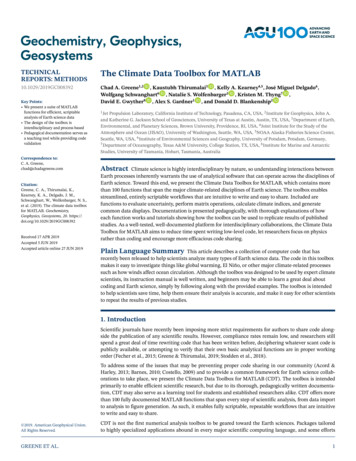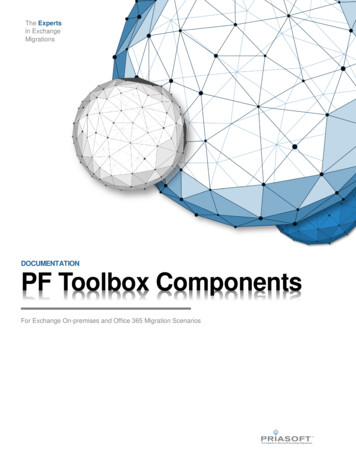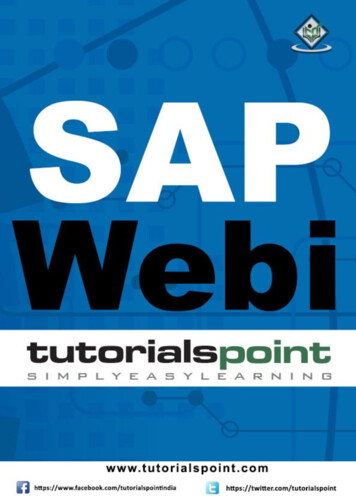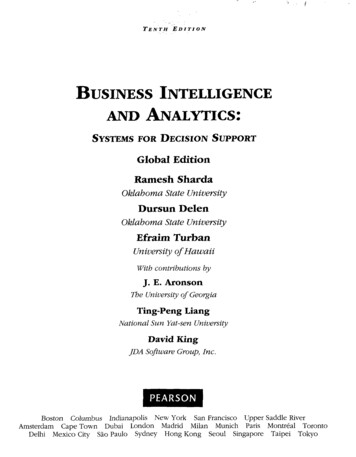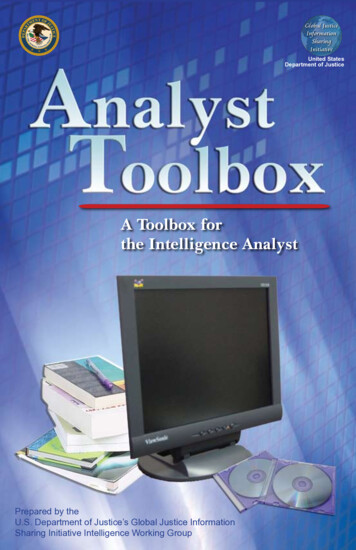
Transcription
JGlobal JusticeInformationSharingInitiativeTICEDEPARN T OFUSETMUnited StatesDepartment of JusticeA Toolbox forthe Intelligence AnalystPrepared by theU.S. Department of Justice’s Global JusticeInformation1Sharing Initiative Intelligence Working Group
About GlobalThe U.S. Department of Justice’s Global JusticeInformation Sharing Initiative (Global) serves as aFederal Advisory Committee to the U.S. AttorneyGeneral on critical justice information sharinginitiatives. Global promotes standards-basedelectronic information exchange to provide justiceand public safety communities with timely, accurate,complete, and accessible information in a secureand trusted environment. Global is administered bythe U.S. Department of Justice, Office of JusticePrograms, Bureau of Justice Assistance.This project was supported by Grant No. 2007-NC-BX-K001 awarded by the Bureau of Justice Assistance, in collaboration with theU.S. Department of Justice’s Global Justice Information Sharing Initiative. The Bureau of Justice Assistance is a component of theOffice of Justice Programs, which also includes the Bureau of Justice Statistics, the National Institute of Justice, theOffice of Juvenile Justice and Delinquency Prevention, the SMART Office, and the Office for Victims of Crime. Points of view oropinions in this document are those of the author and do not represent the official position or policies of the U.S. Department of Justice.2
IntroductionandBackgroundThere is a wide range of software available on the market to supportintelligence analysis. In order to meet the challenges facing lawenforcement today, it is important that intelligence professionals beequipped with the right tools to effectively and efficiently perform theirduties and produce meaningful and useful intelligence products. Thetools examined in this document represent the basic toolbox that theintelligence analyst will need to provide the vital intelligence service thatis expected in today’s law enforcement environment.The National Criminal Intelligence Sharing Plan (NCISP)1—endorsed bythe U.S. Department of Justice (DOJ), the U.S. Department of HomelandSecurity (DHS), and many different law enforcement organizations—contains 28 recommendations for local, state, tribal, and federal lawenforcement agencies to implement in order to improve the quality ofcriminal intelligence in the United States. Two of the recommendationsof the NCISP address the need to properly equip those persons involvedin intelligence analysis: Recommendation 12: The International Association of LawEnforcement Intelligence Analysts (IALEIA) should develop, on behalfof the CICC (Criminal Intelligence Coordinating Council), minimumstandards for intelligence analysis to ensure intelligence products areaccurate, timely, factual, and relevant and recommend implementingpolicy and/or action(s). Law enforcement agencies should adoptthese standards as soon as developed and approved by the CICC. Recommendation 28: The CICC, in conjunction with the Office ofJustice Programs (OJP) and the connected sensitive but unclassifiedsystems, shall develop an acquisition mechanism or centralized sitethat will enable law enforcement agencies to access shared datavisualization and analytic tools. The CICC shall identify analyticalproducts that are recommended for use by law enforcement agencies1Available at www.it.ojp.gov/documents/NCISP Plan.pdf.3
in order to maximize resources when performing intelligencefunctions, as well as a resource list of current users of the products.Pursuant to Recommendation 12, IALEIA developed the LawEnforcement Analytic Standards booklet.2 This booklet providesminimum standards for intelligence analysis to ensure that intelligenceproducts are accurate, timely, factual, and relevant. These standardswere approved by DOJ’s Global Justice Information Sharing Initiative(Global) Advisory Committee in September 2004. Standard 16 of theLaw Enforcement Analytic Standards states that “Analyses shall utilizethe best and most current computerized visualization and analytic toolsavailable to the analyst.”In order to provide law enforcement decision makers with as muchinformation as possible concerning the tools available to the analysisprocess, the Global Intelligence Working Group (GIWG) tasked theConnectivity/Systems Committee to develop a list of tools to fulfill theneeds expressed in NCISP Recommendation 28. To begin the process,a survey was conducted among randomly selected law enforcementanalytic practitioners to determine a baseline of needed tools toadequately perform the analyst function.3Another step in the process of developing tools to aid in the analysisprocess was the coordination with the Office of National Drug ControlPolicy to modify its secure Technology Toolbox for police Web-basedcollaboration programs to accommodate discussion forums for analyticalsoftware. This provides a secure mechanism for law enforcementanalysts to discuss “how to” issues concerning these tools. Additionally,administrators can compare various intelligence products to gauge theeffectiveness of the tools and determine whether they meet the needs ofthe agency. The Technology Toolbox can be reached via RISSNET .The Analyst Toolbox list represents the results of extensive Web-based,open source research and the collection of systems currently utilized bylocal, state, tribal, and federal law enforcement agencies.23Available at www.it.ojp.gov/documents/law enforcement analytic standards.pdf.The results of the survey are attached as Appendix A.4
AnalystToolboxWordProcessingPurpose: To produce textdocuments, including bulletins, factsheets, investigative summaries, andanalytical reports. Analytic products shouldinclude a written report of some length and formatthat can be produced utilizing word processing software.In some instances, the only product of an analysis will be awritten report.Uses: Word processing software includes various formatting tools,such as footnoting, header and footer annotations, mailing labels,and correspondence formatting. This software also enables objects(photographs, graphics, tables, etc.) to be embedded in documents.Word processing software may also include editing and change trackingfeatures for documents being modified by more than one individual.SpreadsheetPurpose: To organize numerical data in a column-and-row format forsummarization and comparison of data and data charting.Uses: Spreadsheets are capable of performing calculations and basicstatistical computations, searches, defined filtering, and sorting ofdata. They are ideal for financial data storage and collation. Data canbe entered by an operator or imported from files of similar structure.Additional capabilities of this tool should include the ability to generategraphs and tables to visualize data. Drawing toolbars may be used tocreate rudimentary link charts and flowcharts.Relational DatabasePurpose: To organize data in relation to other data in a format ofrecords and fields arranged into several tables in order to determinecommonalities and relationships among data. The relational databasetool can also be used for record keeping.5
Uses: Relational database software allows the option of records/fieldswithin a database to be related to other fields (e.g., incident name, time,date, gist, and reported by). Records can be associated with otherrecords by any of the fields (a query for records for a particular date willbring up all records associated with that date; e.g., a query for recordsreported by Officer Jones will retrieve all incidents reported by Jones).Likewise, tables can be related to each other through queries thatconnect similar fields and reduce data entry and repetition. A relationaldatabase also serves as an information management tool. Userinterface can be via simple forms through which data can be entered andfed directly into the database.Mapping/Geographic Information System (GIS)Purpose: To display geographic data using points or shapescorresponding to specific locations or areas on a map to aid in crimemapping and strategic intelligence charting.Uses: Mapping/GIS software can aid in mapping and in the analysis ofdata points or areas related to crime or other patterns (dates, times, hotspots of activity, buffer zones). This software can also be used to look atpatterns of movement relating to crime to delineate “hunting zones” andreduce the number of leads in predatory crimes.Public Information Database ResourcesPurpose: To provide access to compiled public data sources with onecomprehensive search.Uses: Public information records usually include personal information(address, phone number, date of birth) and asset information (real estate,vehicle, businesses). These types of databases are not consideredthe primary data source but are a compilation of information from othersources; therefore, the information should be verified at the primarysource of the information. Law enforcement agencies may havedirect access to these databases, or agencies may access this type ofinformation through the Regional Information Sharing Systems (RISS),Financial Crimes Enforcement Network (FinCEN), National White CollarCrime Center (NW3C), or High Intensity Drug Trafficking Areas (HIDTA).Presentation SoftwarePurpose: To produce professional-looking slide show presentations,with the capability to incorporate text, photographs, graphics, andanimation.6
Uses: Presentation software provides not only slides but also handoutsand presentation outlines that may aid in oral intelligence briefings. Thistool can be used to provide a visual summary of pertinent informationrelating to the investigation or topic being discussed.Graphics SoftwarePurpose: To illustrate concepts or conclusions using graphic arts.Uses: Graphics software allows for cutting and pasting of informationinto other applications for projects beyond the graphics capability of wordprocessing and spreadsheet software, thereby providing a complete anddetailed representation of the applicable data.PDF File Creation SoftwarePurpose: To allow the creation of PDF format files. PDF files can beviewed and printed on any operating system (Mac OS X , Microsoft Windows , UNIX ), thereby facilitating the sharing of information.Uses: PDF files look exactly like original documents and preservesource file information—including text, drawings, 3D, full-color graphics,and photos—regardless of the application used to create them. PDFfiles can also support full-text searches to locate words and phrases.This software can also be utilized to create electronic documents frompaper originals.Statistical Analysis SoftwarePurpose: To analyze large amounts of data to identify trends.Uses: This software enables the user to create descriptive statistics,which in turn allows for the summarization and analysis of qualitativeand quantitative data, using calculations such as frequency, percentchange, mean, median, mode, and measures of variance (SD and SE).Inferential statistics are used for random sampling of populations (asin a survey) and allow the user to inferentially apply the results to thepopulation from which the sample was drawn.Publishing SoftwarePurpose: To produce professional-looking publications, such asnewsletters or bulletins.7
Uses: Publishing software enables the user to create publications tobe distributed on a broad scale. Intelligence that is to be disseminatedshould be converted into a format similar to PDF to ensure that thequality of the document is not altered.Communications/Telephone (Toll) RecordSoftwarePurpose: To organize structured information collected from telephonebilling systems (including cellular phones), pen registers, and dialednumber recorders for analysis.Uses: Communications/telephone records software aids in theanalysis of communication and telephone information, including sourceor destination of a call; the times of calls; and the dates, frequency,sequence, patterns, and duration of calls to/from one or manytelephones. With advancements in communications technologies—suchas e-mail, instant messaging (IM), paging, Voice over Internet Protocol(VoIP), and direct connect technologies—software packages should becapable of dealing with nontraditional communications data elements,such as Internet Protocol (IP) addresses, e-mail addresses, directconnect private identification numbers, and IM account numbers and/orscreen names.Timeline/FlowchartingPurpose: To display chronological events in an easy-to-understandformat.Uses: Timeline/flowcharting can support tactical or strategic planning,as well as investigations. Timeline software tools can visually showthe order of events for an identified or suspected crime. Flowchartingcan visually demonstrate the flow of goods within a criminal enterprise.Timeline/flowcharting can also serve administrative purposes, such asvisual project tracking.Link AnalysisPurpose: To link associated information from a structured data sourceand display the links between entities in a graphic display. Also useful fordocumenting data sources and can help find the links in a large, complexdata set. This type of software can also include a timeline or flowchartingcapability.8
Uses: Link analysis software can visually show relationships, includingassociation analysis and hierarchical relationships (e.g., organized crimehierarchies).Data Mining/Text MiningPurpose: To automate the process of determining patterns andrelationships in extremely large volumes of information (either statisticalor in text) too large for an individual to manage.Uses: Data mining/text mining tools can assist in complex casemanagement where there may be multiple targets, victims, and piecesof information related to the case. These types of tools aid in efficientlyanalyzing large amounts of data.Data VisualizationPurpose: To automatically display information in formats such asgraphs and pie charts. This capability can sometimes be part of a largersoftware application, such as spreadsheet software.Uses: Data visualization software displays the relationships and findingsin an easy-to-read format, such as link charts, flowcharts, or telephonetoll-analysis charts.Investigative Case ManagementPurpose: To track investigations and leads and activities conducted insupport of investigations in order to preserve a record for investigativeand prosecutorial purposes, as well as to manage work flow ofinvestigators and analysts.Uses: Investigative case management tools provide a central repositoryfor all information relating to a case. Users may query the system todetermine whether subjects have previously been identified and currentcase status. This tool can also provide information and reports regardingstrategic planning for law enforcement executives.ConclusionEach organization will have to determine the specific vendor to providethe tools listed in this report. It is important when examining theseproducts that interoperability be considered. In order to connect the dots,law enforcement analysts must have a basic set of tools that providethe services they need and can easily communicate with each other.9
Appendix AResults of Analyst Surveyto Determine ToolsNeeded by AnalystsNovember 2005I. HardwareA. Computer with sufficient processing speed and hard drivecapability to run high-end programs and adequate data storage/memory servers1. CD and DVD Burner capability2. Backup equipment3. Video capture capability4. Laptops if fieldwork is requiredB. Printers1. Laser for high-speed black and white with capability of printingup to 11" x 17" charts and documents2. Color printer with capability of printing up to 11" x 17" chartsand documents3. Graphics plotter capable of printing large chartsC. Document scanner with auto feed and optical characterrecognition (OCR) softwareD. Digital camera(s) (5-megapixel) for surveillance, target photos,and postseizure analysisE. Digital video camera(s)F. Facsimile machineG. Color copierH. Statistical calculatorI. Projection equipmentJ. Television with cable or satellite accessII. Installed SoftwareA.B.C.D.E.F.Word processing programSpreadsheet programRelational databasePresentation software to include photo manipulation/enhancementInternet browserFlowcharting software10
G.H.I.J.K.L.M.N.O.Link analysis softwareDatabase reporting/visualization softwareMapping softwarePhoto enhancement softwareE-mail program to include interoffice with ability to calendar/taskDesktop search engine for local and network drivesTelephone analysis softwarePortable Document Format (PDF) creation softwareSecurity software1. Virus blockers2. Internet restriction3. Firewall4. Smart Pass or other encryption softwareP. Publication softwareQ. Statistical analysis softwareR. Data mining/text mining softwareIII. Access to Systems and DatabasesA.B.C.D.E.F.G.Agency records management systemAgency intelligence systemDirect unfiltered Internet connectionState crime information systemNational crime information systemState driver’s license databaseCommercial databases containing personally identifyinginformationH. Regional Information Sharing Systems (RISS)I. Law Enforcement Online (LEO)J. Homeland Security Information Network (HSIN)K. Telephone databaseL. Jail management databasesM. Financial Crimes Enforcement Network (FinCEN)N. Immigration databasesO. State wage and hour databaseP. State sex offender registriesQ. Crime-specific listservsR. Really Simple Syndication (RSS) readersS. Intelligence center databases (state, HIDTA, EPIC, NDIC, etc.)T. State corrections/probation databasesU. Juvenile justice databasesV. Wireless Internet accessW. Cellular telephone and PDA11
For more information on the U.S. Department of Justice’sGlobal Initiative and its products, including thosereferenced in this document, call (850) 385-0600 or visitwww.it.ojp.govIssued: November 200612Reprinted: November2007
intelligence analyst will need to provide the vital intelligence service that . They are ideal for financial data storage and collation. Data can . tool can be used to provide a visual summary of pertinent informatio
